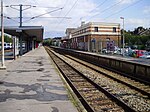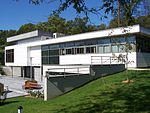The Machine de Marly, also known as the Marly Machine or the Machine of Marly, was a large hydraulic system in Yvelines, France, built in 1684 to pump water from the river Seine and deliver it to the Palace of Versailles.King Louis XIV needed a large water supply for his fountains at Versailles. Before the Marly Machine was built, the amount of water delivered to Versailles already exceeded that used by the city of Paris, but this was insufficient, and fountain-rationing was necessary. Ironically most of the water pumped by the Marly Machine ended up being used to develop a new garden at the Château de Marly. However, even if all the water pumped at Marly (an average of 3,200 cubic metres or 703,902 imperial gallons or 845,351 US gallons per day) had been supplied to Versailles, it still would not have been enough: the fountains running à l'ordinaire (that is, at half pressure) required at least four times as much.The Machine de Marly, based on a prototype at the Château de Modave, consisted of fourteen gigantic water wheels, each roughly 11.5 metres or 38 feet in diameter, that powered more than 250 pumps to bring water 162 metres (177 yd) up a hillside from the Seine River to the Louveciennes Aqueduct. Louis XIV had countless schemes and inventions that were supposed to bring water to his fountains. The Machine de Marly was by far his most extensive and costly plan. After three years of construction and a cost of approximately 5,500,000 livres, the massive contraption, considered the most complex of the 17th century, was completed. "The chief engineer for the project was Arnold de Ville and the 'contractor' was Rennequin Sualem (after whom the quai by the machine is now named)." Both men had experience in pumping water from coal mines in the region of Liège (in modern Belgium).The machine suffered from frequent breakdowns, required a permanent staff of sixty to maintain and often required costly repairs. It functioned for 133 years. Destroyed in 1817, it was replaced by a "machine temporaire" during 10 years and then a steam engine entered in service from 1827 to 1859. From 1859 to 1963, the pumping at Marly was assumed by another hydraulic machine conceived by the engineer Xavier Dufrayer. Dufrayer's machine was scrapped in 1968 and replaced by electromechanical pumps.











